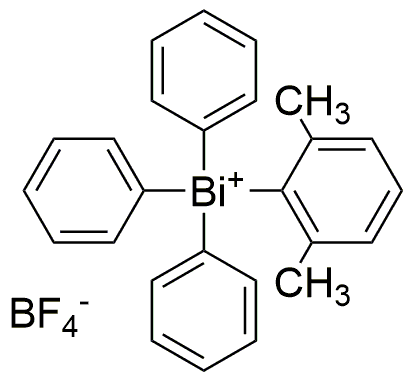Triphenyl-2,6-xylylbismuthonium tetrafluoroborate is widely utilized in research focused on:
- Organic Synthesis: This compound serves as a versatile reagent in organic chemistry, facilitating the synthesis of complex organic molecules through its unique reactivity.
- Coordination Chemistry: It is employed in the preparation of bismuth-based coordination complexes, which are valuable in various catalytic processes and materials science.
- Pharmaceutical Development: Researchers utilize this compound to explore new drug formulations, particularly in the development of bismuth-containing pharmaceuticals that may have enhanced therapeutic properties.
- Material Science: It plays a role in the development of advanced materials, such as polymers and nanocomposites, due to its unique electronic properties.
- Environmental Applications: The compound is investigated for its potential use in environmental remediation processes, particularly in the removal of heavy metals from contaminated sites.
General Information
Properties
Safety and Regulations
Applications
Triphenyl-2,6-xylylbismuthonium tetrafluoroborate is widely utilized in research focused on:
- Organic Synthesis: This compound serves as a versatile reagent in organic chemistry, facilitating the synthesis of complex organic molecules through its unique reactivity.
- Coordination Chemistry: It is employed in the preparation of bismuth-based coordination complexes, which are valuable in various catalytic processes and materials science.
- Pharmaceutical Development: Researchers utilize this compound to explore new drug formulations, particularly in the development of bismuth-containing pharmaceuticals that may have enhanced therapeutic properties.
- Material Science: It plays a role in the development of advanced materials, such as polymers and nanocomposites, due to its unique electronic properties.
- Environmental Applications: The compound is investigated for its potential use in environmental remediation processes, particularly in the removal of heavy metals from contaminated sites.
Documents
Safety Data Sheets (SDS)
The SDS provides comprehensive safety information on handling, storage, and disposal of the product.
Product Specification (PS)
The PS provides a comprehensive breakdown of the product’s properties, including chemical composition, physical state, purity, and storage requirements. It also details acceptable quality ranges and the product's intended applications.
Certificates of Analysis (COA)
Search for Certificates of Analysis (COA) by entering the products Lot Number. Lot and Batch Numbers can be found on a product’s label following the words ‘Lot’ or ‘Batch’.
*Catalog Number
*Lot Number
Certificates Of Origin (COO)
This COO confirms the country where the product was manufactured, and also details the materials and components used in it and whether it is derived from natural, synthetic, or other specific sources. This certificate may be required for customs, trade, and regulatory compliance.
*Catalog Number
*Lot Number
Safety Data Sheets (SDS)
The SDS provides comprehensive safety information on handling, storage, and disposal of the product.
DownloadProduct Specification (PS)
The PS provides a comprehensive breakdown of the product’s properties, including chemical composition, physical state, purity, and storage requirements. It also details acceptable quality ranges and the product's intended applications.
DownloadCertificates of Analysis (COA)
Search for Certificates of Analysis (COA) by entering the products Lot Number. Lot and Batch Numbers can be found on a product’s label following the words ‘Lot’ or ‘Batch’.
*Catalog Number
*Lot Number
Certificates Of Origin (COO)
This COO confirms the country where the product was manufactured, and also details the materials and components used in it and whether it is derived from natural, synthetic, or other specific sources. This certificate may be required for customs, trade, and regulatory compliance.


